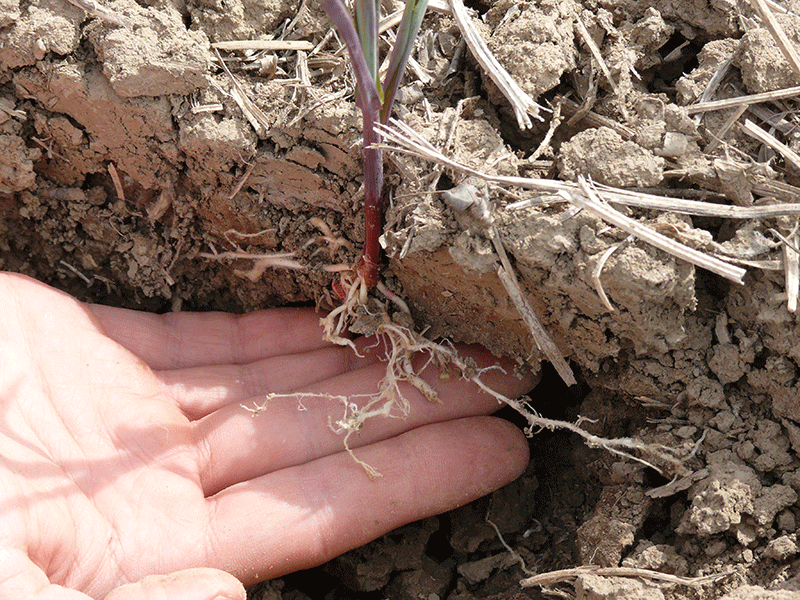Farm lightly
PREVENTING OR MITIGATING COMPACTION
COMPACTION IS A topic that every farmer must take seriously. Soil compaction causes damage to the soil structure and makes it much more difficult for plants to grow because it reduces the ability of soil to retain and facilitate the movement of what’s needed for good crop root growth — water, nutrients, and air.

In-season compaction is getting more common and more serious with the growing use of new equipment like self-propelled sprayers, notes Doug Young, a professor at the University of Guelph Ridgetown Campus. “I appreciate that fungicides are time-sensitive, and you sometimes can’t wait for the soil to dry out because wet conditions are exactly what fungal diseases like. But these new sprayers weigh up to 16 tonnes before liquid is added, which can in itself total over 4 tonnes, and we really want any piece of equipment and its carried materials to be 6 tonnes or less per axle on a field of crops.”
The very large planters available today can also cause substantial compaction. “They are 12 to 14 tonnes now and then you add seed and a 30,000-pound tractor in front,” Young says. “Six rows of a field get that weight — that’s a quarter of the field getting a lot of compaction going deep into the soil.”
After-market tire deflation systems can help, and although Young notes that a lot of them are slow on the re-inflation (ten minutes or more), a couple of newer systems re-inflate in one or two minutes.
None of them are inexpensive, however. This year there was some financial assistance available under the Ontario Great Lakes Agricultural Stewardship Initiative (delivered through Ontario Soil and Crop Improvement Association), but Anne Verhallen, horticulture soil management specialist at the Ontario Ministry of Agriculture, Food and Rural Affairs, says whether it will be on the list next year remains to be seen.
The expense of a deflation system can be worth it, in Young’s view, depending on the load and if you have the acreage. “They are worthwhile with large manure spreaders or large centre-field planters in the spring when soil is very susceptible to compaction,” he explains. “It’s a bit of a catch-22 on larger farms, because your equipment is going to be larger and heavier but the larger booms allow you to spread out the seeding or fungicide application to avoid some compaction that way.”
With 90 or 100 foot booms, you may only compact two per cent of the field, but Young says it’s critical to use the same pathway each time. This is standard on the large swaths of cropland in Western Canada.
“Controlling traffic is really important,” Young stresses. “Farmers are doing this to some extent, but many could do more. Make a plan to match all your equipment. Match your 24-row planter to the boom on your sprayer. Maybe you have to get a different boom, maybe you have to change where you enter the field. And if you hire out your spraying or you switch companies, you need to communicate effectively and make sure they stick to the farm traffic plan. It’s easier now with GPS systems.”
THE TIME IS NOW
If farmers noticed compaction problems after wheat harvest this summer, they should waste no time in acting. “This is a great time to start addressing problems,” Young says. “It’s a quieter time and it’s usually nice and dry.”
Verhallen agrees. She notes that a shovel makes a good diagnostic tool for shallow compaction.
“Start in areas where the crop isn’t doing as well,” she says. “Dig an area around the roots of several plants and simply examine them. You’ll be able to see if roots are restricted. Look for roots that are flattened instead of round. You may see areas where roots will shoot out in a fan where the compaction is not as severe, or stubs where the plant has tried to send roots into the soil but can’t get any further.”
To investigate deep compaction, various tools such as tile probes can be used, which farmers make themselves or purchase at some farm equipment outlets.
While all types of soil can become compacted, Verhallen has seen some of the most severe in sandy loam soils. “Don’t think that because it’s sand, it drains fast and doesn’t stay wet that it won’t compact as much as a clay soil,” she notes. “Remember that there is a reason sand is used for laying patio bricks and so on — it packs very nicely.”
In terms of reversing compaction, Young and Verhallen both advise planting cover crops.
“Cover crops also add organic matter, as does spreading manure, which helps prevent compaction, but they are not the be-all end-all,” Young says. “One year of cover crops will not solve your problem, but deep large roots breaking through the compaction layer every year will help.”
Verhallen says barley, oats, and rye do a good job at restoring soil structure, as do longer-term cover crops like clover or rotational forage crops like alfalfa.
“Repairing deep compaction in soil takes time,” she notes. “Be patient. If the compaction is severe, measure the depth of compaction and make sure the soil below is dry and able to fracture. Use deep tillage set at just below the compaction layer and then plant a cover crop to stabilize the fractures you’ve created. Then put further cover crop plans, controlled traffic plans, and so on into place.”
While the damage caused by compaction is not simple or quick to reverse, Verhallen and Young note that you will get there if you stick to a long-term plan. •

















